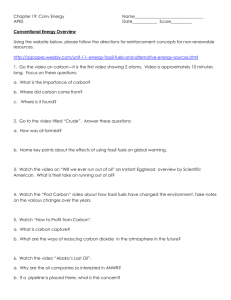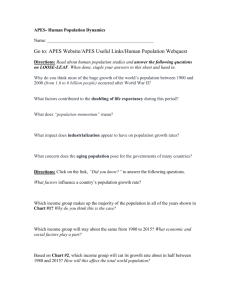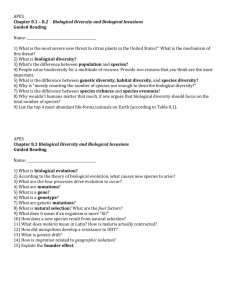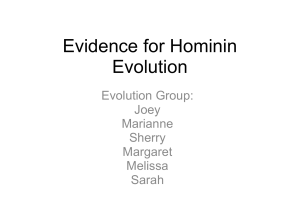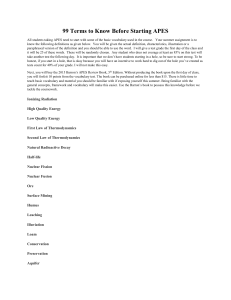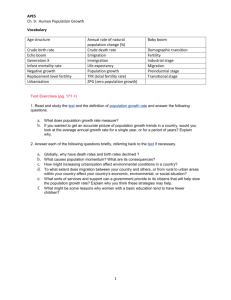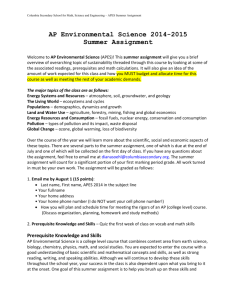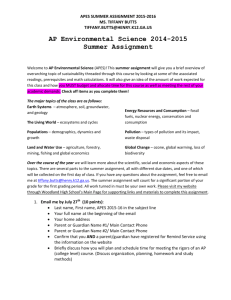Welcome to AP Environmental Science
advertisement
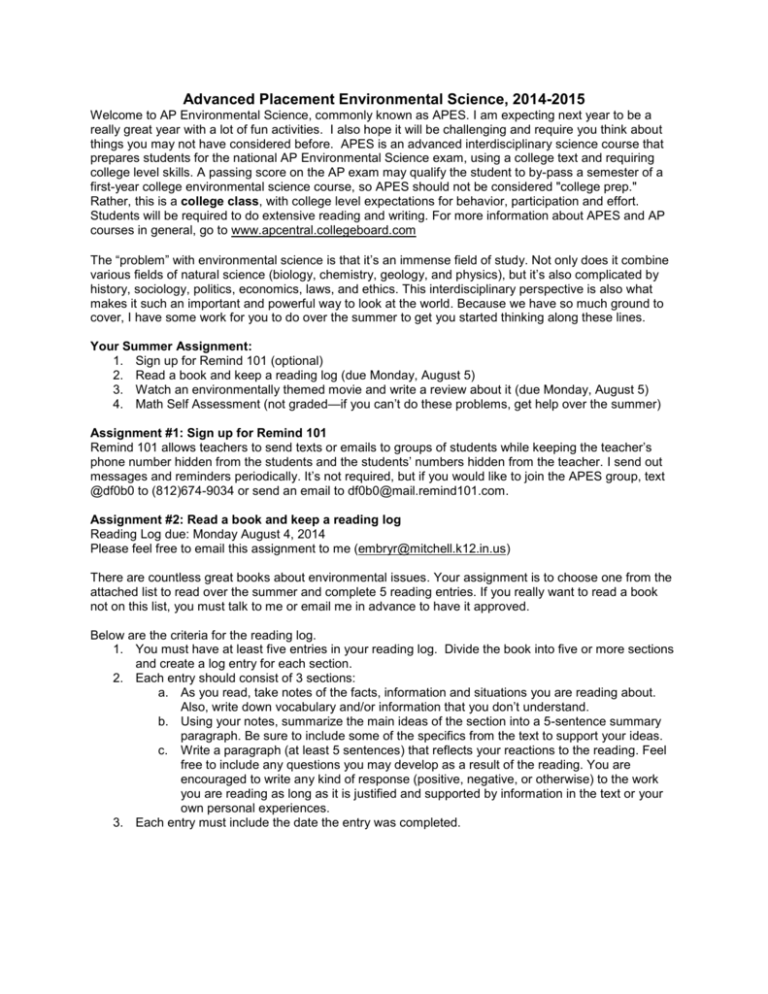
Advanced Placement Environmental Science, 2014-2015 Welcome to AP Environmental Science, commonly known as APES. I am expecting next year to be a really great year with a lot of fun activities. I also hope it will be challenging and require you think about things you may not have considered before. APES is an advanced interdisciplinary science course that prepares students for the national AP Environmental Science exam, using a college text and requiring college level skills. A passing score on the AP exam may qualify the student to by-pass a semester of a first-year college environmental science course, so APES should not be considered "college prep." Rather, this is a college class, with college level expectations for behavior, participation and effort. Students will be required to do extensive reading and writing. For more information about APES and AP courses in general, go to www.apcentral.collegeboard.com The “problem” with environmental science is that it’s an immense field of study. Not only does it combine various fields of natural science (biology, chemistry, geology, and physics), but it’s also complicated by history, sociology, politics, economics, laws, and ethics. This interdisciplinary perspective is also what makes it such an important and powerful way to look at the world. Because we have so much ground to cover, I have some work for you to do over the summer to get you started thinking along these lines. Your Summer Assignment: 1. Sign up for Remind 101 (optional) 2. Read a book and keep a reading log (due Monday, August 5) 3. Watch an environmentally themed movie and write a review about it (due Monday, August 5) 4. Math Self Assessment (not graded—if you can’t do these problems, get help over the summer) Assignment #1: Sign up for Remind 101 Remind 101 allows teachers to send texts or emails to groups of students while keeping the teacher’s phone number hidden from the students and the students’ numbers hidden from the teacher. I send out messages and reminders periodically. It’s not required, but if you would like to join the APES group, text @df0b0 to (812)674-9034 or send an email to df0b0@mail.remind101.com. Assignment #2: Read a book and keep a reading log Reading Log due: Monday August 4, 2014 Please feel free to email this assignment to me (embryr@mitchell.k12.in.us) There are countless great books about environmental issues. Your assignment is to choose one from the attached list to read over the summer and complete 5 reading entries. If you really want to read a book not on this list, you must talk to me or email me in advance to have it approved. Below are the criteria for the reading log. 1. You must have at least five entries in your reading log. Divide the book into five or more sections and create a log entry for each section. 2. Each entry should consist of 3 sections: a. As you read, take notes of the facts, information and situations you are reading about. Also, write down vocabulary and/or information that you don’t understand. b. Using your notes, summarize the main ideas of the section into a 5-sentence summary paragraph. Be sure to include some of the specifics from the text to support your ideas. c. Write a paragraph (at least 5 sentences) that reflects your reactions to the reading. Feel free to include any questions you may develop as a result of the reading. You are encouraged to write any kind of response (positive, negative, or otherwise) to the work you are reading as long as it is justified and supported by information in the text or your own personal experiences. 3. Each entry must include the date the entry was completed. Book List for Assignment #2 Where to find one of these books if you don’t want to buy it: Some of these books are available in my classroom library or in my personal library. Talk to me before school is out for the summer, and you may check them out from me. Check the public libraries. If they don’t have the one you want, they can often get an interlibrary loan. They may even have electronic copies or audio books available for loan. The coupon attached to this packet is good for a free book from Inklings, a used bookstore in Bedford (1020 16th Street). Use it for this assignment, or use it to buy another book to read this summer. A Sand County Almanac, by Aldo Leopold (1949) A collection of essays written in a style similar to Thoreau. A bit on the philosophical side, read this as a collection over time, not as a cover-to-cover read in a few sittings. Silent Spring, by Rachel Carson (1962) A classic book that helped launch the environmental movement in the 1960s. Written for the general public about scientific issues to make her case about the danger of DDT in our environment in an indisputable way. The Diversity of Life, by E.O. Wilson (1992) (Chapters 1-10 are optional, chapters 11-15 are required) E. O. Wilson, a Pulitzer Prize winning Harvard biology professor, coined the word “biodiversity,” and in this book he describes how the species of the world became so diverse, the threats to this diversity, and why it matters. The Omnivore’s Dilemma, by Michael Pollan (2007) A book about food: where it comes from, and how it’s processed. Pollan investigates fast food, the organic movement, locally grown food, and hunting/gathering. Ishmael by Daniel Quinn (1992) The narrator answers an ad in a local newspaper from a teacher looking for serious pupils, only to find himself alone in an abandoned office with a full-grown gorilla. Ishmael is a creature of immense wisdom and he has a story to tell, one that no other human being has ever heard. Like all great teachers, Ishmael refuses to make the lesson easy; he demands the final illumination to come from within ourselves. No Impact Man, by Colin Beavan (2009) A man and his family try to live for one year without having any negative impact on the environment. Collapse, by Jared Diamond (2011) Reviews the causes of historical and pre-historical incidences of societal collapses such as Easter Island, Norse society in Greenland, the Maya, and the Anasazi The Cartoon Guide to the Environment, by Larry Gonick and Alice Outwater (1996) (Google Cartoon Guide to the Environment to find the entire book online at this link: http://lake.k12.fl.us/cms/lib05/FL01000799/Centricity/Domain/3480/CARTOON%20GUIDE%20T O%20THE%20ENVIRONMENT.pdf) Covers the main topics of Environmental Science with a sense a humor using cartoons. Plastic Purge, by Michael SanClements (2014) A guide to understanding the role of plastics in our world, including how to comfortably avoid unnecessary plastic products The Boy Who Harnessed the Wind, by William Kamkwamba and Bryan Mealer (2010) William Kamkwamba was born in Malawi, a country where magic ruled and modern science was mystery. It was also a land withered by drought and hunger. But William had read about windmills, and he dreamed of building one that would bring to his small village a set of luxuries that only 2 percent of Malawians could enjoy: electricity and running water. A Walk in the Woods, by Bill Bryson (1998) Bill Bryson, a reluctant adventurer if ever there was one, undertakes a grueling hike along the world's longest continuous footpath—The Appalachian Trail. With his offbeat sensibility, his eye for the absurd, and his laugh-out-loud sense of humor, Bryson recounts his confrontations with nature at its most uncompromising over his five-month journey. Assignment #3: Watch a movie with a message Movie review due Monday, August 5 There have been lots of movies with an environmental theme; some are better than others. Choose one of these to watch during your summer break and write a 50 to 100 word movie review about the one you watch (this can be submitted electronically also: embryr@mitchell.k12.in.us). These reviews will be shared with your classmates, so be sure to make a recommendation about whether they should see it or not by ranking on a scale of 1 to 5 stars. Here are the movies you can choose from, in no particular order: Avatar (James Cameron) Medicine Man (Sean Connery) The Lorax (animated; new version or old one) Erin Brockovitch (Julia Roberts) A Civil Action (John Travolta) Wall-E (animated) Day after Tomorrow Whale Rider The Road (Viggo Mortenson) FernGully: The Last Rainforest (animated) Idiocracy (2006) Biodome (Pauly Shore) Hoot Water World (Kevin Costner) China Syndrome (Jane Fonda) King Corn (documentary) Food, Inc (documentary An Inconvenient Truth (documentary) March of the Penguins Free Willy Star Trek IV Chinatown (Jack Nicholson) Gorillas in the Mist (Sigourney Weaver) Dances with Wolves (Kevin Costner) Pocahontas (animated) Fly Away Home (Anna Paquin) Into the Wild Spirit: Stallion of the Cimarron (animated) Assignment #4: Math Self Assessment Being able to do basic math is essential to this course. We will have to do math calculations in several assignments throughout the year, and we will not have time to review the basics. Go over this help sheet and complete the attached problem set. This will not be graded; however, there will be weekly quizzes that include math problems. Get help and do lots of practice this summer if you don’t feel like you are up to speed on all of these types of math problems, otherwise your quiz grades will suffer. Basic operations without a calculator Calculators are not allowed on the APES Exam, so you will need to be comfortable doing addition, subtraction, multiplication, and division without an electronic crutch. Class activities sometimes require calculators, but you will not be able to use calculators on the weekly quizzes. Scientific Notation If you are used to having your calculator figure this out for you, you’’ll need to practice scientific notation. Thousand = 103 =1,000 Million = 106 =1,000,000 (people in the US = 310 million) Billion = 109 =1,000,000,000 (people on Earth = 7 billion; age of the Earth = 4.6 billion years) Trillion = 1012 =1,000,000,000,000 (National debt = $17 trillion) When using very large numbers, scientific method makes numbers easier to manipulate. For example, the US population is 300 million people or 300x106 or 3x108 When adding or subtracting, exponents must be the same. Add the numbers in front of the ten and keep the exponent the same. When multiplying or dividing, multiply or divide the number in front of the ten and add the exponents if multiplying or subtract the exponents if dividing Dimensional Analysis You should be able to convert any unit into any other unit accurately if given the conversion factor. Online tutorials are available: http://www.chemprofessor.com/dimension_text.htm http://www.chem.tamu.edu/class/fyp/mathrev/mr‐da.html Metric Prefixes m (milli) =1/1000 =10‐3 c (centi) =1/100 =10‐2 k (kilo) =1000 =103 M (mega) =1,000,000 =106 G (giga) =1,000,000,000 =109 T (tera) =1,000,000,000,000 =1012 Percentages: Be able to solve problems using fractions and percentages. APES Math Problems Answer the questions. Use a separate sheet of paper if necessary. Show all work neatly. 1. What is one million times one thousand? Show your work in scientific notation. Give the answer in scientific notation and in words. 2. A population of deer had 200 individuals. If the population grows by 15% in one year, how many deer will there be the next year? 3. Last year I had 14 AP Environmental Science students and next year I will have 32 AP Environmental Science students, what percentage did the population of APES students grow by? 4. Electricity costs 6 cents per kilowatt hour. In one month one home uses one megawatt hour of electricity. How much will the electric bill be? Use dimensional analysis to solve. 5. Your car gets 15 miles to the gallon and your friend’s car gets 25 miles to the gallon. You decide to go on a road trip to Chicago, which is 300 miles away. If gas costs $4 per gallon and you decide to split the gas money, how much money will you save in gas by driving your friend’s car? Use dimensional analysis to solve. 6. Virginia Beach is 15 kilometers wide and 50 kilometers long. If 2 cm of rain falls on Virginia Beach, how many cubic meters of rain fell on Virginia Beach? (Hint: convert all units to meters first). 7. An MP3 takes up about 16 kilobytes of memory per second of music. If you owned a one terabyte hard drive and filled it with only mp3s, how many days worth of music would you have? Use dimensional analysis to solve. Assignment #5: Go APES! Optional activities, no due date Here are some ways you can “GO APES” this summer. None are required; all are fun. Instead of driving, ride a bike or take a walk Get wet in a downpour (not in a thunderstorm) Follow a stream to its headwaters Follow a stream to its mouth Speaking of water, where does yours come from? Watch an ant colony Study the waves at the beach Spend time at the Spring Mill Lake and observe succession in action (what’s succession???) Solve the local deer overpopulation problem Visit the Lawrence County recycling facility; make some contributions Watch the Discovery Channel Figure out why dew forms on the grass at night, but not every night Compare star counts in Mitchell vs. your vacation spot (lay on your back and count stars on a clear night) Celebrate “meatless Mondays” by following a vegetarian diet one day a week Be a “vegan before 6:00 p.m.” No animal products until after 6:00 every day Play around with Google Earth Grow your favorite vegetable Look at a big tree and determine where all that mass came from Go fishing Follow the path of your favorite gem or precious metal from mine to your ring finger Pretend that you have no electricity for an evening Where does your electricity come from, and why does it matter? Camp out, even if it’s in your back yard Pick berries Use sunscreen regularly Change your light bulbs from incandescent to compact fluorescent bulbs Relate the heating of your car’s interior on a sunny day to the greenhouse effect Watch some birds or bats Compare the color and ‘blinking’ patterns of different fireflies/lighting bugs Visit a farm, or at least the farmer’s market Have a septic tank? How does it work? Read the Wall Street Journal Tired of the phrase “going green?” Come up with another term. Buying organic food? Not buying organic food? Does it matter? At the pool? Figure out how many gallons of water it takes to fill it up.

